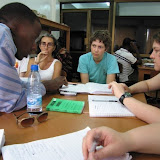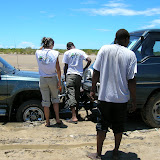Sub-Saharan Africa is more heavily affected by HIV and AIDS than any other region of the world. An estimated 24.5 million people were living with HIV at the end of 2005 and approximately 2.7 million new infections occurred during that year.1 In just the past year the epidemic has claimed the lives of an estimated 2 million people in this region. More than twelve million children have been orphaned by AIDS
The extent of the epidemic is only now becoming clear in many African countries, as increasing numbers of people with HIV are becoming ill. In the absence of massively expanded prevention, treatment and care efforts, it is expected that the AIDS death toll on the continent will continue to rise. This means that the epidemic's impact on these societies will be felt most strongly in the course of the next ten years and beyond. Its social and economic consequences are already widely felt, not only in the health sector but also in education, industry, agriculture, transport, human resources and the economy in general.
How are different countries in Africa affected?
HIV prevalence rates vary greatly between African countries. In Somalia and Senegal the prevalence is under 1% of the adult population, whereas in South Africa and Zambia around 15-20% of adults are infected.
In four southern African countries, the national adult HIV prevalence rate has risen higher than was thought possible and now exceeds 20%. These countries are Botswana (24.1%), Lesotho (23.2%), Swaziland (33.4%) and Zimbabwe (20.1%).
West Africa has been less affected by HIV, but the prevalence rates in some countries are creeping up. Prevalence is estimated to exceed 5% in Cameroon (5.4%), Côte d'Ivoire (7.1%) and Gabon (7.9%).
Until recently the national prevalence rate has remained relatively low in Nigeria, the most populous country in Sub-Saharan Africa. The rate has grown slowly from below 2% in 1993 to 3.9% in 2005. But some states in Nigeria are already experiencing HIV infection rates as high as those now found in Cameroon. Already around 2.9 million Nigerians are estimated to be living with HIV. Adult HIV prevalence in East Africa exceeds 6% in Uganda, Kenya and Tanzania.
Trends in the epidemic
Large variations exist between the patterns of the epidemic in individual countries. In some places, the HIV prevalence is still growing. In others it appears to have stabilised and in a few African nations - such as Kenya and Zimbabwe - declines appear to be underway, probably in part due to effective prevention campaigns. Others countries face a growing danger of explosive growth. The sharp rise in HIV prevalence among pregnant women in Cameroon (more than doubling to over 11% among those aged 20-24 between 1998 and 2000) shows how suddenly the epidemic can surge.
Overall, rates of new HIV infections in Sub-Saharan Africa appear to have peaked in the late 1990s, and HIV prevalence seems to be levelling off, albeit at an extremely high level. Stabilisation of HIV prevalence occurs when the rate of new infections is equalled by the death rate among the infected population. This means that a country with a stable but very high prevalence must be suffering a very high number of AIDS deaths each year. Although prevalence remains stable, the actual number of Africans living with HIV is rising due to general population growth.
What is the effect of these levels of infections?
Over and above the personal suffering that accompanies HIV infection, the epidemic in Sub-Saharan Africa threatens to devastate whole communities, rolling back decades of development progress.
- Sub-Saharan Africa faces a triple challenge of colossal proportions:
- Providing health care, support and solidarity to a growing population of people with HIV-related illness, and providing them with treatment.
- Reducing the annual toll of new infections by enabling individuals to protect themselves and others.
- Coping with the cumulative impact of over 20 million AIDS deaths on orphans and other survivors, on communities, and on national development.
What is the impact of HIV & AIDS on Africa?
HIV & AIDS are having a widespread impact on many parts of African society. The points below describe some of the major effects of the epidemic. For a more detailed examination,
- In many countries of Sub-Saharan Africa, AIDS is erasing decades of progress made in extending life expectancy. Millions of adults are dying young or in early middle age. Average life expectancy in Sub-Saharan Africa is now 47 years, when it could have been 62 without AIDS.
- The effect of the epidemic on households can be very severe. Many families are losing their income earners. In other cases, income earners are forced to stay at home to care for relatives who are ill from AIDS. Many of those dying have surviving partners who are themselves infected and in need of care. They leave behind children grieving and struggling to survive without a parent's care. See our AIDS orphans page for more about the effect of the epidemic on children.
- In all affected countries, the HIV/AIDS epidemic is putting strain on the health sector. As the epidemic develops, the demand for care for those living with HIV rises, as does the number of health workers affected.
- Schools are heavily affected by HIV/AIDS. This a major concern, because schools can play a vital role in reducing the impact of the epidemic, through education and support.
- HIV/AIDS dramatically affects labour, setting back economic activity and social progress. The vast majority of people living with HIV/AIDS in Africa are between the ages of 15 and 49 - in the prime of their working lives. Employers, schools, factories and hospitals have to train other staff to replace those at the workplace who become too ill to work.
- Through its impacts on the labour force, households and enterprises, HIV/AIDS can act as a significant brake on economic growth and development. HIV/AIDS is already having a major affect on Africa's economic development, and in turn, this affects Africa's ability to cope with the epidemic.
HIV prevention in Africa
A continued rise in the number of Africans living with HIV is not inevitable. There is growing evidence that prevention efforts can be effective, and this includes initiatives in some of the most heavily affected countries.
In some countries there have been early and sustained prevention efforts. For example, effective prevention campaigns have been carried out in Senegal, which is still reflected in the relatively low adult prevalence rate of 0.9%. Also, the experience of Uganda shows that a widespread epidemic can be brought under control. HIV prevalence in Uganda fell from around 15% in the early 1990s to around 5% by 2001. This change is thought to be largely due to intensive HIV prevention campaigns.
More recently, similar declines have been seen in Kenya, Zimbabwe and urban areas of Zambia and Burkina Faso. However, the extremely severe epidemics in South Africa, Swaziland and Mozambique continue to grow.
Overall a massive expansion in prevention efforts is needed, and although there is no single or immediate tool to prevent new infections, the major components of a successful prevention programme are now known.
Condom use
Condoms play a key role in preventing HIV infection around the world. In Sub-Saharan Africa, most countries have seen an increase in condom use in recent years. In studies carried out between 2001 and 2005, eight out of eleven countries in Sub-Saharan Africa reported an increase in condom use.3
The distribution of condoms to countries in Sub-Saharan Africa has also increased: in 2004 the number of condoms provided to this region by donors was equivalent to 10 for every man,4 compared to 4.6 for every man in 2001.5 In most countries, though, many more condoms are still needed. For instance, in Uganda between 120 and 150 million condoms are required annually, but less than 40 million were provided in 2005.6
Relative to the enormity of the HIV/AIDS pandemic in Africa, providing condoms is cheap and cost effective. Even when condoms are available, though, there are still a number of social, cultural and practical factors that may prevent people from using them. In the context of stable partnerships where pregnancy is desired, or where it may be difficult for one partner to suddenly suggest condom use, this option may not be practical.
Provision of Voluntary Counselling & Testing (VCT)
The provision of voluntary HIV counselling and testing (VCT) is an important part of any national prevention program. It is widely recognised that individuals living with HIV who are aware of their status are less likely to transmit infection to others, and that through testing they can be directed to care and support that can help them to stay healthy. VCT also provides benefit for those who test negative, in that their behaviour may change as a result of the test. The provision of VCT has become easier, cheaper and more effective as a result of the introduction of rapid HIV testing, which allows individuals to be tested and find out the results on the same day. VCT could – and indeed needs to be – made more widely available in most Sub-Saharan African countries.
Mother-to-child transmission
Around 2 million children in Sub-Saharan Africa were living with HIV at the end of 2005. They represent more than 85% of all children living with HIV worldwide.7 The vast majority of these children will have become infected with HIV during pregnancy or through breastfeeding when they are babies, as a result of their mother being HIV-positive.
Mother-to-child transmission (MTCT) of HIV is not inevitable. Without interventions, there is a 20-45% chance that a HIV-positive mother will pass infection on to her child. If a woman is supplied with antiretroviral drugs, though, this risk can be reduced significantly. Before this measures can be taken the mother must be aware of her HIV-positive status, so testing also plays a vital role in the prevention of MTCT.
In many developed countries, these steps have helped to virtually eliminate MTCT. Yet Sub-Saharan Africa continues to be severely affected by the problem, due to a lack of drugs, services and information. The shortage of testing facilities in many areas is also contributing. Fewer than 6% of pregnant women in Sub-Saharan Africa were offered services to prevent MTCT in 2005.8 Given the scale of the MTCT crisis in Africa, it is remarkable that more is not being done (by both the international community and domestic governments) to prevent the rising numbers of children becoming infected.
HIV/AIDS related treatment and care in Africa
Antiretroviral drugs
Antiretroviral drugs (ARVs) - which significantly delay the progression of HIV to AIDS and allow people living with HIV to live relatively normal, healthy lives – have been available in richer parts of the world since around 1996. Distributing these drugs requires money, a well-structured health system and a sufficient supply of healthcare workers. The majority of developing countries are lacking in these areas and have struggled to cope with the increasing numbers of people requiring treatment.
For most Africans living with HIV, ARVs are still not available - fewer than one in five of the millions of Africans in need of the treatment are receiving it. Many millions are not even receiving treatment for opportunistic infections, which affect individuals whose immune systems have been weakened by HIV infection. These facts reflect the world’s continuing failure, despite the progress of recent years, to mount a response that matches the scale and severity of the global HIV/AIDS epidemic.
Botswana pioneered the provision of ARVs in Africa, starting its national treatment program in January 2002. By September 2005 this program was providing treatment to around 54,378 people living with HIV. According to World Health Organization figures, 85% of people in need of treatment were receiving it at the end of the year, including those using the private sector. Thousands of lives have been saved as a result.
While most African countries have now started to distribute ARVs, progress in providing sufficient quantities of the drugs has been uneven and Botswana’s success has not been emulated elsewhere. Among the other countries that have made advances is Uganda, where more than half the people in need of ARVs are receiving them. In Cameroon, Côte d’Ivoire, Kenya, Malawi and Zambia, between 17% and 27% of people requiring antiretroviral drugs were receiving them in mid-2005. While South Africa is the richest nation in Sub-Saharan Africa and should have led the way in ARV distribution, its government was slow to act; so far, only 21% of those in need of treatment in South Africa are receiving it. In other countries, such as Ethiopia, Ghana, Mozambique, Nigeria, the United Republic of Tanzania and Zimbabwe, the figure is less than 10%.9
Nonetheless, the overall situation is slowly improving; the number of people receiving ARVs in Africa doubled in 2005 alone.10 International support has helped this increase, with numerous governments and international organizations encouraging progress. In 2003 the World Health Organization (WHO) initiated the ‘3 by 5’ program, which aimed to have three million people in developing countries on ARVs by the end of 2005. While this target was not reached, a number of African nations made substantial progress under the scheme. The latest international target, is aiming at universal access to treatment by 2010. Under this program it is hoped that considerable progress will be made in Africa.
There are still, however, a number of impediments to ARV provision. One major challenge is the fact that the majority of African countries have a poor healthcare infrastructure and a shortage of medical professionals. A considerable emphasis needs to placed not only on the availability of ARVs, but also the availability of professionals who are able to administer the drugs.
Another major challenge is ensuring that drugs are not only supplied to a lot of areas, but that sufficient quantities of drugs are supplied to those areas. This is critically important, because once an individual starts to take ARVs they have to take them for the rest of their life. If, for instance, their local hospital runs out of ARVs, the interruption that this causes in their treatment could result in them becoming resistant to the drugs. To improving treatment programs, African countries face the double challenge of getting new people to start treatment and maintaining the supply of treatment to those who are already receiving ARVs.
Other forms of treatment and care
Treatment and care for HIV/AIDS consists of a number of different elements apart from ARVs. These include voluntary counseling and testing, food and management of nutritional effects, follow-up counseling, protection from stigma and discrimination, treatment of other sexually transmitted infections, and the prevention and treatment of opportunistic infections. All of these things can, and indeed should, be provided before ARVs are available. This does not exclude the provision of ARVs when they are available. Indeed, when ARVs do become available the provision of antiretroviral therapy should be easier and quicker to implement because many of the things apart from drugs that are needed for successful treatment are already in place.
What needs to be done to make a difference in Africa?
International support
One of the most important ways in which the situation in Africa can be improved is through increased funding. More money would help to improve both prevention campaigns and the provision of treatment and care for those living with HIV. Developed countries have increased funding for the fight against AIDS in Africa in recent years, perhaps most significantly through the Global Fund to fight AIDS, Tuberculosis and Malaria. The Global Fund was started in 2001 to co-ordinate international funding and has since approved grants totaling US $3.3 billion to fight HIV and AIDS in Africa.11 Around 60% of the fund’s grants have been directed towards Africa and 60% has been put towards fighting AIDS.12 This funding is making a significant difference, but given the massive scale of the epidemic more money is still needed.
The US Government has shown a commitment to fighting AIDS in Africa through the President’s Emergency Plan For AIDS Relief (PEPFAR). Started in 2003, PEPFAR provides money to fight AIDS in numerous countries, including 15 focus countries, most of which are African. In Fiscal Year 2005, PEPFAR allocated US $1.1 billion to these African focus countries.13 The US Government is also the largest contributor to the
~Global Fund~
Domestic commitment
More than money is needed if HIV prevention and treatment programs are to be scaled up in Africa. In order to implement such programs, a country’s health, education, communications and other infrastructures must be sufficiently developed. In some African countries these systems are already under strain and are at risk of collapsing as a result of AIDS. Money can also only be used efficiently if there are sufficient human resources available, but there is an acute shortage of trained personnel in many parts of Africa.
In many cases, African countries also need more commitment from their governments. There are promising signs that some governments are starting to respond and becoming more involved, and this commitment needs to be sustained if the impact of the epidemic is to be reduced.
Reducing stigma and discrimination
HIV-related stigma and discrimination remains an enormous barrier to the fight against AIDS. Fear of discrimination often prevents people from getting tested, seeking treatment and admitting their HIV status publicly. Since laws and policies alone cannot reverse the stigma that surrounds HIV infection, more and better AIDS education is needed in Africa to combat the ignorance that causes people to discriminate. The fear and prejudice that lies at the core of the HIV/AIDS discrimination needs to be tackled at both community and national levels.
Helping women and girls
In many parts of Africa, as elsewhere in the world, the AIDS epidemic is aggravated by social and economic inequalities between men and women. Women and girls commonly face discrimination in terms of access to education, employment, credit, health care, land and inheritance. These factors can all put women in a position where they are particularly vulnerable to HIV infection. In Sub-Saharan Africa, around 59% of those living with HIV are female.
In many African countries, sexual relationships are dominated by men, meaning that women cannot always practice safe sex even when they know the risks involved. Attempts are currently being made to develop a microbicide – a cream or gel that can be applied to the vagina, preventing HIV infection – which could be a significant breakthrough in protecting women against HIV. Women could apply such a microbicide without their partner even knowing. It is likely to be some time before a microbicide is ready for use, though, and even when it is, women will only use it if they have an awareness and understanding of HIV and AIDS. To promote this, a greater emphasis needs to be placed on educating women and girls and adapting education systems (which are currently male-dominated) to their needs.
The way forward
Tackling the HIV and AIDS crisis in Africa is a long-term task that requires sustained effort and planning - both within African countries themselves and amongst the international community. One of the most important elements of the fight against HIV and AIDS is the prevention of new infections. Prevention campaigns that have been successful within African countries need to be highlighted and repeated.
The other main challenge is providing treatment and care to those living with HIV in Africa, in particular ARVs, which can allow people living with HIV to live long and healthy lives. Many African countries have made significant progress in their treatment programs in recent years and it is likely that the next few years will see many more people receiving the drugs.
References
1. UNAIDS, '2006 Report on the Global AIDS Epidemic'
2. Ibid.
3. UNAIDS, '2006 Report on the Global AIDS Epidemic', Chapter 3: Progress in Countries
4. UNFPA website, Condom Programming
5. Shelton J.D. and Johnston B. (2001), 'Condom gap in Africa: evidence from donor agencies and key informants'
6. Kaisernetwork.org (September 2005), 'US has increased global condom distribution in recent years, targeting mostly high-risk groups'
7. UNAIDS, '2006 Report on the Global AIDS Epidemic'
8. Ibid.
9. World Health Organisation (March 2006), Progress on Global Access to HIV Antiretroviral Therapy: A Report on 3 by 5 and beyond
10. UNAIDS, '2006 Report on the Global AIDS Epidemic', Chapter 7: Treatment and care
11. The Global Fund to fight AIDS, Tuberculosis and Malaria (September 2005), Grants to Countries in Africa, Rounds 1-5 Funding
12. The Global Fund to fight AIDS, Tuberculosis and Malaria website, FAQ
13. PEPFAR (February 2006), 'Action Today, A Foundation For Tomorrow: Second Annual Report to Congress on the President's Emergency Plan for AIDS Relief'











No comments:
Post a Comment